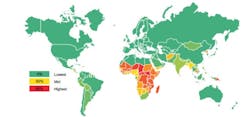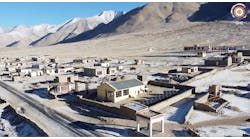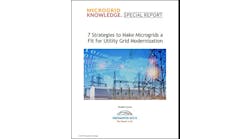Distributed renewables, energy storage and microgrid controllers are set to play a bigger role as India looks to improve power generation, extend universal energy access, and achieve climate targets, according to Bloomberg New Energy Finance (BNEF).
Off-grid and grid-connected, distributed solar currently makes up just a small percentage of India’s generation capacity. But that’s changing as politicians look ahead to upcoming national elections in 2019, and solar, battery-based energy storage and microgrids gain increasing support for their substantial benefits.
While the trend is national, it is particularly notable in states such as Uttar Pradesh and Bihar, which are largely rural and make up what’s known as the Hindi Heartland, said BNEF’s Itamar Orlandi during a Nov. 23 webinar.
Share of the Population without Grid Access (% of total)
Source World Bank, BNEF
A tale of two India’s
An estimated 30 GW of distributed solar, energy storage and microgrid opportunities are shaping up across India as the majority Bharatiya Janata Party, which is led by Prime Minister Narendra Modi, looks to realize a pledge to improve grid services and achieve universal energy access in 2019.
India has one of the world’s largest economies, as well as one of the world’s largest and fastest growing clean energy markets. Yet some 40 million households across the country remain “unelectrified,” Orlandi said during the webinar: “Frontier Power: Market Trends in the 30-GW Energy Access Market.” Orlandi leads BNEF’s Frontier Power Research.
In addition to lowering costs and providing reliable and resilient access to energy, distributed energy resources can boost economic growth and job creation, particularly in rural areas and across the agricultural sector. Those are key factors in India’s political calculus, a point that isn’t lost on the nation’s politicians, particularly as national elections draw near, said Ashish Sethia, who leads BNEF’s Asia-Pacific research group.
Power generation capacity and quality are improving across India. And both utility-scale and distributed renewables are contributing to the trend. In fact, a solar energy boom is under way, Sethia said.
An Indian solar boom
BNEF expects 6.7 GW of solar capacity to be installed in India this year, a lot more than the 3.7 GW installed in 2016. In addition, the clean energy market research specialist expects the Indian government to auction another 17 GW of solar energy project awards over the course of the next few months.
Though small in terms of total generation capacity, rooftop solar has been growing at an annual rate of around 117 percent since 2013. About 700 MW of rooftop solar has been installed in India so far this year, according to Sethia.
As is the case in the US and worldwide, China is the dominant exporter of solar PV modules to India. Some 60 percent of Chinese PV module exports go to emerging markets, and 50 percent of those wind up in India, BNEF says. The large majority of Indian imports are installed as part of utility-scale solar energy projects connected directly to the power grid.
India’s federal government runs national auctions and tenders as a means of awarding large-scale solar and wind power projects. Prices of winning bids continue to fall, now averaging around $38/MWh, according to BNEF.
“They’re (renewable energy auction prices) not the lowest in the world, but they are quite low in the context of India’s power market, more particularly given the high cost of debt,” Sethia noted.
The politics of universal energy access
BNEF expects market momentum to grow as the Indian government and industry leaders look to enhance grid services, achieve universal energy access and reduce greenhouse gases. These achievements would provide political capital for those up for re-election in 2019’s national elections.
Hindi Heartland states, such as Uttar Pradesh and Bihar, are particularly important, and politically valuable, in this regard, Sethia said. “It’s important for any political party to provide electricity access in these states.”
Interested in renewable microgrids? See the Microgrid Knowledge special report, “The Rise of Clean Energy Microgrids.”
PM Modi and the national government recently set the goal of achieving universal energy access in 2018, which includes extending electricity lines to every Indian village by the end of this year, and to every Indian household by the end of next year, Sethia said.
To achieve these goals, 3.3 million households will have to be connected to electricity service each month for the next 13 or 14 months, according to BNEF estimates. India can put to use both its new generation capacity and its significant amount of underutilized capacity, according to Sethia.
“Recent government policies have translated into actions relatively well – the duration of outages is declining, which the government claims was down from 9 percent to 2 percent in 2016,” he said. “The other number to look at is the number of unelectrified villages, which remained high until 2014 when the rural electrification was launched.”
Rural electrification
The number of unelectrified Indian villages has declined significantly. However, the government’s definition of “unelectrified” is somewhat weak, as is the case with its definition of grid-connected Indians, Sethia noted.
Villagers or urban households in cities and urban areas with new grid connections may not have 24×7 grid electricity service, for example.
The large bulk of the gains in rural electrification can be attributed to growing installations of solar PV, battery energy storage and small-scale microgrids in Indian rural communities, Sethia said.
[clickToTweet tweet=”India’s Universal Energy Access Drive Opens Up 30-GW Market Opportunity #microgrid” quote=”India’s Universal Energy Access Drive Opens Up 30-GW Market Opportunity”]
Early on, decision-makers identified the value of solar PV for agricultural irrigation as they formulated national renewable and energy access goals. The number of such projects has been on the rise. BNEF sees the market segment as posing attractive, untapped opportunities for private sector solar, battery storage and microgrid vendors and project developers.
“Agriculture represents about 18 percent of electricity consumption in India, and there are about 8 million diesel irrigation pumps, so it’s a huge demand center,” Sethia said.
Furthermore, the Indian government and distribution utilities subsidize agricultural energy consumption heavily. Doing so can leave distribution utilities in the red. Hence it makes sense for the government to support distributed solar and microgrids in agricultural communities since they can decrease electricity subsidies and fuel costs.
“They (the government) has been doing that since the 1990s, but it’s really in the last year or two that we’ve seen rapid acceleration in the pace of solar irrigation pumps being installed. More were sold in the last year than in the past decade,” Sethia said.
Hybridizing diesel fuel generation
The BNEF India research duo identified two other promising, relatively untapped energy access market opportunities during the webinar.
First, Indian energy services companies are pairing solar PV and in some cases battery energy storage with India’s large population of diesel fuel generators, which are frequently relied upon for extended periods of time given the still comparatively poor reliability of grid power. Instances where these are being integrated and managed by microgrid control systems have emerged as well.
Second, BNEF sees renewable, distributed energy and microgrid business opportunities at fuel stations. The market situation here is similar to that in the agriculture and hybrid solar-diesel market segments in that individual installations can be quite small, but they can be significant – multiple MW in scale – given the number of potential project sites, according to Sethia.
“The largest fuel distributors have already put solar in place in about 25 percent of their fuel stations, about 26 MW of PV power capacity,” Sethia said. “In many cases, the driver isn’t just cost reduction. They’re at the edge of the grid and in many cases do not have access to grid power all day, so they turn on diesel generators when they need to pump fuel.”
But doing so takes time and it’s costly.
“By installing solar they can save money on utility tariffs and fuel, and have more reliable operations. Also, they don’t forgo sales, so the value per kilowatt-hour is far larger in this segment than just the cost of an electron,” Sethia said.
Read more about India’s drive for universal energy access. Follow Microgrid Knowledge on LinkedIn.







